Lea Wait's Blog, page 307
October 31, 2014
Weekend Update: November 1-2, 2014
 Next week at Maine Crime Writers there will be posts by Sarah Graves (Monday), Kate Flora (Tuesday), Kaitlyn Dunnett/Kathy Lynn Emerson (Wednesday), and Vicki Doudera (Thursday). On Friday, Saturday, and Sunday November 7-9) we’ll post special reports from New England Crime Bake.
Next week at Maine Crime Writers there will be posts by Sarah Graves (Monday), Kate Flora (Tuesday), Kaitlyn Dunnett/Kathy Lynn Emerson (Wednesday), and Vicki Doudera (Thursday). On Friday, Saturday, and Sunday November 7-9) we’ll post special reports from New England Crime Bake.
In the news department, here’s what’s happening with some of us who blog regularly at Maine Crime Writers:
 Kaitlyn Dunnett/Kathy Lynn Emerson: No particular news from me, but I want to share a photo I love. This is “Grimmy” (aka The Grim Reaper), who appears every Halloween on a lawn in East Wilton, Maine to delight trick-or-treaters and grownups alike. Readers of this blog have met Grimmy’s creators before, in my post about adventures in cat-sitting. I wonder if it’s significant that Ed and Trish were trying to get my BLACK cat to take her pills while I was at Malice Domestic?
Kaitlyn Dunnett/Kathy Lynn Emerson: No particular news from me, but I want to share a photo I love. This is “Grimmy” (aka The Grim Reaper), who appears every Halloween on a lawn in East Wilton, Maine to delight trick-or-treaters and grownups alike. Readers of this blog have met Grimmy’s creators before, in my post about adventures in cat-sitting. I wonder if it’s significant that Ed and Trish were trying to get my BLACK cat to take her pills while I was at Malice Domestic?
An invitation to readers of this blog: Do you have news relating to Maine, Crime, or Writing? We’d love to hear from you. Just comment below to share. Don’t forget that comments are entered for a chance to win our wonderful basket of books and the very special moose and lobster cookie cutters.
And a reminder: If your library, school, or organization is looking for a speaker, we are often available to talk about the writing process, research, where we get our ideas, and other mysteries of the business. Contact Kate Flora: mailto: kateflora@gmail.com
October 30, 2014
Maine Librarians Share Their Scariest Books

No screaming in the library, even if the book scares you to death!
As our readers are well aware, Maine Crime Writers love our Maine librarians, so it’s fun for us to turn to them from time to time with questions. This month’s question, in honor of Halloween, was to ask them what was their scariest book.
You will not be surprised to find that Maine’s own Stephen King tops the list. Dogs and cars have never been the same since King got his pen on them, and he was onto the risks of bullying long before it became a topic of general conversation. Of course, King is not the only choice, so read on, to see what our librarians had to say.
Peggy O’Kane, Coordinator of Public Services, Maine State Library:
In 1974, when Helter Skelter: The True story of the Manson Murders was published I was a junior in high school. My home was across the Ohio River from Moundsville, WV site of the West Virginia State Penitentiary a location mentioned more than once in the book describing Charles Manson’s youth. My social studies class toured the prison. Its castle like stone walls painted a perfect picture of a gothic castle in decay.
The night I read the book I was, naturally, home alone. Yes, there was a torrent of wind and rain. Yes, my old house creaked and yes, prison breaks were not uncommon. There followed many sleepless nights waiting for knives, ritual murder and blood.
Peggy adds: Much as I enjoy your writing, Kate, I no longer read true crime…

A rather spooky looking photo of the Belfast Library
Steve Norman from the Belfast Library is also in the nonfiction camp with this book:
A Need to Kill, by Mark Pettit (c 1990).
A serial killer with roots in Maine. I read it right after moving to Maine. His mother worked in the same room where I was working. Too close to home!!!
Katie Connor, director of the Brewer Library, offered a very interesting book and some insights about why she chose it:
I am not a huge fan of horror, suspense, etc, so I tend to veer away from those books. I can say that Cujo by Stephen King was terrifying enough in the first two chapters that I closed it and never picked it up again. Dark nights and things lurking in closets are already nightmares, and I found myself not being able to sleep at night, waiting for a voice to call me from my closet. Silly, I know, but like I said– not really my thing.

A sunny photo of the Brewer Library contrasts with the tale of a dark book
The scariest book I read and finished was The People of Forever are not Afraid, by Shani Boianjiu. It is the coming-of-age story of three best friends who grew up in the same Israeli village, begin their mandatory military service the same year and receive vastly different assignments. From guarding Palestinian checkpoints, to checking trucks on the Egyptian border, to patrolling small village areas, from “safe” service to active duty, the girls are assaulted, again and again, by the violence both of their inner lives and the world they live in. Forced to enact decisions they hate, and enabled to become things they’d always hated, each girl makes choices that slowly drive them closer to insane violence . . . or will their choices veer toward salvation in the end?
I think this book terrified me because of the inner changes the reader witnesses in each protagonist. The entire structure of how our environment can wreck or redeem us, how each person’s inner turmoil is generally about a hundred times worse than the outward chaos of their worlds, was sobering. I also found it horrific how, though each girl cried for justice in different areas of her life, her hopes were slammed into the earth over and over. The smashing of their hopes led the girls, in different ways, to become the sort of monsters that they had abhorred. It was a striking reminder that, though each human being has a choice in whether they will join or defy the violence of the world, all too often it is the easier road of violence that we choose– especially if violence has been inflicted upon us.
As readers and writers, we appreciate these kinds of insights. Not simply books that make us worry about monsters under the bed, but about the monsters we might become and how the monstrous people we write about have been shaped.
In a similar vein, Gretchen Asam from SAD1 offers this:
It has to be Shirley Jackson’s Haunting of Hill House, not because of what it says but because of what it doesn’t. It’s like a catalyst between the page and the imagination. She doesn’t scare you as much as you terrify yourself. Winner hands down.
Perrin Joel Lumbert, from the Bates College, Ladd Library has suggestions for both fiction and nonfiction:
Scariest Books:
Fiction: The Alienist, by Caleb Carr (1994)
Nonfiction: The Coming Plague: Newly Emerging Diseases in a World Out of Balance, by Laurie Garrett (1995)
Harold writes: when I think of scary literature, “Blood Music” is what comes to mind. Greg Bear is a science fiction writer with a flair for biological science. His stuff tends to be apocalyptic and cerebral.
Also tossing both fiction and non-fiction into the ring is Dina McKelvey, librarian at Maine Medical Center, who chose:
Communion by Whitley Strieber
In Cold Blood by Truman Capote
Saying: Could be because I read them both straight through and into the middle of the night!
Susan Taylor from Hampden’s Edythe Dyer Library says her scariest books was “Secret Smile” by Nicci French. “It was psychologically suspenseful, hard to put down, and totally creeped me out.”
Karen Westerberg, librarian at the Wells Elementary School, is in the Stephen King camp, choosing Cujo by Stephen King
As is Cathy Perkins at the Waterville Public Library:
Stephen King’s Salem’s Lot! Couldn’t put in down, finished it at 2 in the morning – didn’t sleep a wink afterwards while I watched every shadow on the wall with great trepidation!
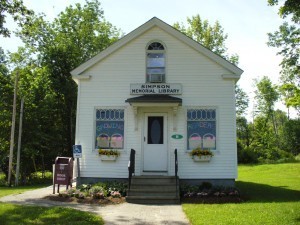
The Simpson Memorial Library in Carmel
And Becky Ames:
Here at Simpson Memorial Library in Carmel, it would have to be Stephen King’s books. When someone asks for horror the next word out of their mouth’s is usually Stephen King. OF his books, Salem’s Lot, for me, takes the cake. When it came out I was pregnant with my first child, didn’t realize what it really was about. I started reading it at 10:00 at night, hubby was working. I’m alone in a 200+ year old house with big… windows. Scared myself silly.
October 28, 2014
Books You Should Never Read at Night . . .

When your imagination is tweaked, even the ordinary can be scary
Two years ago, in our Halloween post, we listed our scariest books and asked our readers to share theirs. So here are some of the responses that we got. Now you can join the conversation:
Sandy Gardner: The scariest book I ever read, hands down, was “On the Beach.” I think the writer was Nevil Shute, but I’m not sure. The whole scenario, about a nuclear war and its aftermath, scared me for years. I still get shivers when I think about it. The reason, I think, was that it was so real– especially during that time, the Cold War.
Mo Walsh: I found “River of Darkness” by Rennie Airth so scarey because it was so realistic. The novel starts with the murder of a household in a small village in post-WWI England. We quickly learn who the killer is (though the detective does not yet know) and follow him as he stalks his next victims. The tension between the killer spiraling out of control and the detective’s methodical investigation kept me figuratively on the edge of my chair, shouting “Hurry up! Think faster! He’s going to kill them!” It’s heightened by the killer’s psychopathology: he’s a born killer whose instincts finally find free reign when he’s trained by the Army in how to kill efficiently. Serial killers have always been with us.
Jeanne at the Bristol Public Library: I’ve been posting some of our favorite spooky books at the library

Hauntingly beautiful by day, but at night?
bookblog, but honestly I sort of quit reading horror after having the dickens scared out of me by Richard Matheson’s Legend of Hell House aka Hell House aka Richard Matheson’s Hell House. I didn’t think it was all that scary while reading it but it gave me terrible nightmares. The other one that creeped me out was Helter Skelter. The randomness of it all, I guess.
Thelma Straw: I’m with those of you who named Red Dragon… whenever I start a new novel with a creepy killer, I reread bits of it to get myself in gear to write that sort of thing – As a person, I am generally peaceful and calm-thinking, but I seem to always write about a really creepy scary psychopath!
Librarian Shannon Jensen: As a reader of thrillers, suspense, horror and supernatural fantasy, I always assumed that I’ve read so much graphic violence, murder and mayhem that over the course of my reading career I had become jaded to it. That was, until I read SHADOW MAN by Cody McFadyen. At first I though it was just going to be another run-of-the-mill thriller, I’ve read thousands of them. But this one had me glancing over at the door to make sure it was locked and doing a round of the house’s windows to make sure they were all secure. When a patron comes into my library telling me they want something scary, it’s the first book I go for. We’ve replaced it three times since it was published because it goes out that often.
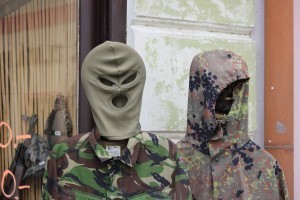
Just a street display. But at night, how would they seem?
Pat Brown: The scariest book I ever read had to be Phantoms by Dean Koontz. Reading it, I had no idea what was going on which is what scares me. The first time I read Salem’s Lot by King I was so unnerved I couldn’t read it at night (I lived alone then) up until the moment I knew the monster was a vampire. After that it no longer bothered me and I not only finished it, but read it a couple more times.
Lorraine Gelly: In Cold Blood by Truman Capote. I still think of the daughter putting her watch in her shoe. For some reason that always seemed to stay with me.
Lisa: Shirley Jackson’s “The Haunting of Hill House”.
“…silence lay steadily against the wood and stone of Hill House, and whatever walked there, walked alone.”
I get goosebumps just thinking of it. My goodness, I love her. Brilliant.
Chris Colter: Most likely it was a function of my age at the time (11 years old), but a novelization of

Just some twisted roots, or a monster? Old bones? Something waiting to come alive?
George Romero’s “Dawn of the Dead” rocked my socks more than any horror/suspense novel before or since. Stephen King’s “Pet Sematary” also got to me, but I was a bit older and not quite so impressionable when I read it.
Janet McCord: Patricia Cornwell’s first Kay Scarpetta book, “Postmortem” was the first book I ever read that gave me nightmares. I was living in Virginia at the time, not too far south of Richmond where the book was set and to know that it was based on a real case I suppose, made it all the more real and frightening to me. I was never one to seek out or enjoy graphic crime or hard-boiled mysteries but this one gripped me because Cornwell is such a good writer. It was my first “serial killer” book and it was very scary. Right now I’m reading “Dracula” for the first time and I wasn’t expecting how atmospheric and chilling it is. I’m completely repulsed by the descriptions of the insanity of the character Renfrew. It’s making more of an impression on me than I thought it would!
October 27, 2014
A Modest Proposal-Maine Style

I’m ready to cap unnecessary spending.
Do you have the same urge to cringe every time the phone rings these days? Between the artificially cheery college students trying to make a connection with a codgerly alum from 40 years ago and get said alum to pony up an additional donation to the college they can barely remember, and the drone-voiced person who insists the survey they want you to complete over the phone has nothing to do with politics, it’s almost worth disconnecting the blasted thing.
Last I heard, this off-year election was costing better than three billion. That’s sixty million per state. What if we took that money and did something useful with it. At $30,000 per inpatient stay, we could treat 500 addicts and alcoholics per year (15 million) and probably keep a third of them out of the criminal justice system for a fair amount of time, netting some sort of return. If we invested the remainder in two and four year college scholarships and required the recipients to stay in-state for a corresponding number of years after graduation, we might actually create some of that work force everyone agrees we don’t have and desperately need. (at an average cost of 15,000 per year, we could fund 3000 years of scholarships with the remaining 45 million).
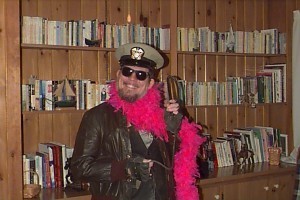
I know how to dress for success.
Instead we’re getting our airwaves filled with nastiness and our mailboxes with political filth. If you look dispassionately at the people running for the top offices, they’re not very sexy in terms of fresh and innovative ideas IMHO. While it’s late in the game, I can’t resist putting my alternative candidacy out there for those hungry for a real choice.
Let’s start with disclosures. These days you can’t burp in a cave without someone noticing, so it’s best to come clean right from the git-go. I used to be the person everyone’s mother warned them about. I lied, stole, terrorized and was scary as hell when I got behind the wheel. My language was terrible and when I was a kid, I hated to brush my teeth (dentists have been thanking me ever since) I drank too much, used more drugs than ten medicare recipients combined and sold my conscience in Uncle Henrys for $25.00. I’m sober, drive carefully and am boringly honest these days, although my teeth will never grace a TV ad. If you can wrap your head around that, then vote for me. If you can’t, no hard feelings, but at least I’ve saved the muckrakers a lot of wasted time digging into my past.
Now for the planks in my platform.
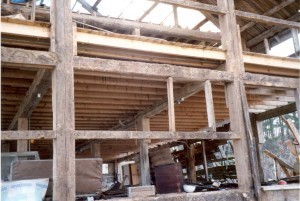
As you can see, all my planks are out in the open.
#1-Legalize marijuana. Moral issues never work well when government is involved. Heck, half of Somerset County grows it already, so why not give them more incentive to earn a decent living. It beats the heck out of getting 34 hours at minimum wage in a big box store every week with no benefits. We’ll tax the heck out of it and use every cent to fund substance abuse treatment. The minute ANY legislator tries to shift a dime, we flog them on live TV, no exceptions.
#2-Are you as tired of bond issues as I am? It seems that every other year, we’re promised that going into hock for another twenty million is going to create gazillions of jobs. Has it ever happened? How many of the jobs promised ten years ago are still there? Thought so. This may seem like a completely unrelated question, but have you tried to get a plumber or an electrician on short notice recently? How about a furnace repairman? Every one I’ve talked to in the last few years had had the same lament. Kids aren’t going into the trades any more, and if they do, they go to work for big companies of leave the state. How about we take a lesson from the middle ages and try a modified guild approach? There are kids in almost every town who are naturally adept at things like plumbing, auto repair and electrical wiring. Many don’t think about going on to school or just plain can’t afford it. Why not pass a bond issue that will pay for them to apprentice with local, close to retirement people in these trades. When the mentor is satisfied the young person knows their stuff, money from the bond goes into a no-interest loan so the younger person can buy out the retiring skilled person and their shop so they can go right to work. In return, they sign an agreement to remain in the area for a ten year period, and the loan is held in abeyance until the ten years is up. If they fulfill the commitment, the loan is wiped out.
#3-If you’ve followed what the UMO research folks can do when they’re turned loose, you know how awesome the Bridge in a Backpack is and that they’re getting some pretty interesting results with their wood composite research. Let’s give them enough money so they can do some ‘star wars’ kinds of product research. Think how cool it would be if they were able to take the ‘you can’t kill me’ gene from poplars and get it to work in pine, spruce and hemlock. Instead of a giant stump left behind to rot, three or four new evergreens pop up the year after the original tree was cut. Next, we get them to grow a successful hybrid using blueberries and Macintosh apples. We know how popular blueberries have become, thanks to their antioxidant properties. Suppose you could harvest ones that were three inches in diameter.
#4-Look around most towns and cities in Maine. There are still plenty of buildings and factories that are unused and will eventually fall down. If you’ve seen what has been done with some of them in terms of retrofitting them (like the Cotton Mill Apartments in Hallowell), many can be turned into pretty decent housing. We have an underutilized resource in our older citizens, many of whom have raised children quite successfully. Plenty of them are having trouble making ends meet. We also have a terrible problem with twenty-somethings who couldn’t parent properly if you put a gun to their head, but we’re bound and determined that we must preserve dysfunctional families. Folks, it doesn’t work. I propose that we offer those wise elders free rent in retrofitted housing in return for their foster grandparent skills. We reduce anxiety in senior citizens and provide loving and stable living arrangements for kids who desperately need them. A potential bonus is those who bond will be more willing to help care for the elderly when they need someone.
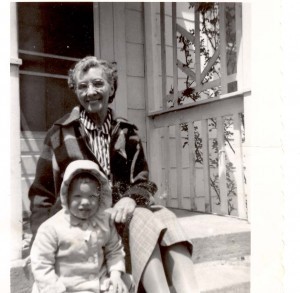
A famous Maine author with her paternal grandmother
#5-I worked for the State of Maine for over 30 years and know from personal experience that many state employees get burned out and become cynical when they’re stuck in the same job too long. I propose that state employees have a ‘sabbatical’ every five years and swap jobs with someone in a completely different field. Imagine battle fatigued caseworkers from human services getting a chance to work as a park ranger for a year. It might backfire big time, but it’s worth a try.
#6-We have a shortage of devils advocacy in state government. If elected, I will veto ANY bill that does not clearly indicate where funding to keep it working will come from ten years down the road. I’ve seen too much stuff mandated on schools and town government by both the federal and state governments without either or both ponying up the coins to cover costs in subsequent years. Who gets blamed when the taxpayers are upset at having to pay for them once the outside money dries up? Generally it’s the poor souls on the local school board, that’s who.
#7-I’ve had a chance to work with plenty of good Maine people who have lost jobs because plants closed or downsized and sent jobs overseas. Many of these folks worked hard for many years. All of a sudden they’re dropped into a world where everyone expects them to be computer literate and understand how to fill out a job application online. Heck, many of these people never touched a computer until they got laid off. Their anxiety and stress levels are through the roof already without the added expectation that they must fill out a form that, to them, makes as much sense as ancient Greek. I have a huge beef with many online applications. Human resource higher-ups think it’s cool as hell to have them on the web, but very few of them ever take time to road test them before letting them become the only way to apply. I’ve sat with perfectly intelligent job seekers who have ended up in tears because the blasted form timed out, wouldn’t work with any browser except internet explorer (which I hate with a passion), failed to save data, or refused to allow the person trying to fill it an opportunity to edit what they’d already entered. I’m proposing that there be a single job application form on the Maine State website with easy to understand instructions and has been tested so it’s bulletproof. All jobs offered within the stare must be linked to this database. That doesn’t mean they can’t be advertised in the classified section of Maine newspapers, but if we have one portal for employers and job seekers, we’re going to have fewer frustrated people and jobs could be filled faster.
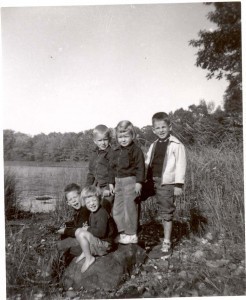
I was building consensus early on.
#8-Paul LePage has things completely backward in terms of immigrants. Let’s face it, Maine is rapidly getting older, whiter and wrinkled as all get out. Unless we get really creative, we’re all going to have to ‘depend’ on each other and the results will NOT be anything we want. I’m proposing we welcome as many immigrants as want to come to Maine. Here in Hartland, we currently have some 45 abandoned of for sale properties. Why not fill them with eager, intelligent and grateful people who can, and probably would, fix them up and create that workforce we’re going to need if we expect the state to have a snowball’s chance in hell of remaining viable. There will be one caveat. Every one signs a good behavior pledge and if they screw up often enough or bad enough, they waive due process and are shipped down to the coast where they become lobster bait.
#9-Ever hang around the state house when the legislature is in session? Talk about pompous windbags, they go on forever. It’s ten times worse in Washington, but we can’t do much about that. If elected, I’m issuing the following edict: All legislative hearings and debates will be conducted in the nude with public TV having full access to stream live broadcasts. In addition to speeding things up, it should encourage more legislators to take physical fitness seriously.
#10-If you spend much time in rural areas away from the coast, you probably know that dental hygiene isn’t a priority. Sadly, teeth are seen as a disposable commodity in many parts of the state. If elected, I’m pushing to find a way to provide free dental care for everyone until age 21, with low-cost dental insurance after that point. Sure it will be expensive, but are you going to hire a twenty-two year old with half his/her teeth rotting? It’s also something that affects good dietary habits and does a big number on self-esteem. My hope is that in a generation or two, we can change the prevailing mindset.
#11-Last, but not least, it’s time we made guys more accountable for their part in unplanned pregnancies. Sure, anyone can make one mistake, but when I see or hear about someone in their late twenties who has four kids by three different women and is still blowing most of whatever money they has on four-wheelers and Twisted Tea, that dude needs a dope slap. If I’m elected, you’re gonna wear a male chastity belt after the second kid and it doesn’t come off until you sign up for a vasectomy and go through with it. I hear those stainless steel models are a bear when you hit a bump when 4-wheeling.

I knew things weren’t what they were cracked up to be at a very young age.
Well, there you have it. I hope I’m offering voters a clear and refreshing choice this time around. As Boss Tweed so aptly put it many years ago…Vote early and vote often on election day.
Off, Off, and Away
Dorothy Cannell here: In forty five minutes, it would be shorter if my husband had his way, we will be leaving for a writers conference in Indiana. I am not packed, and I have yet to have a bath. I look around my house in disappointment that it has allowed itself to get muddley without any assistance from me, and I think vaguely about the panels I am assigned to participate in and wonder if it possible to suddenly refuse to leave unless we fly (first class) instead of driving. We travel decidedly fourth class because our car is small. My husband (presently current one, but just let him put one foot wrong) views traveling from Maine to Indiana in a cramped state guaranteed to worsened arthritis as a fun-filled adventure. Stopping for meals always adds to the excitement. I point out a restaurant, the first seen in one hundred and thirty nine miles, and he says “Oh, woops! Missed it” as if we just escaped a bullet as we head into a desert. Nitpickers may say there are no deserts between Maine and Indiana, and maybe I am stretching to include rutted gravel paths that wind on until every motel looks certain to be a mirage, if only spouting plastic palm trees.
I am in this doleful frame of mind because I have been racing to finish a project and am now left wondering if I’ll ever come up with anything else to write about; and half hoping I won’t because sometimes it comes to me that writing is real work, and I get crabby when people keep asking if I’m not done yet as thought I’ve been indulging in a three month manicure. Of course once I get to the Magna Cum Murder the conference in Indiana I will cheer up enormously and remember what a wonderfully fun breezy job this is, because I so much love being around the ‘write’ sort of people.
Sorry this is a short blog, though I don’t see why I should feel guilty, except that being married to a retired lawyer I know that when the they write briefs they really mean ‘longs’, so I guess that makes their job a lot more real than mine. Still, I do hope I may be excused to go and have my bath, remember to pack for more than one day, and plot how to get the driver to stop at a slow food restaurant.
Happy rest of the month. Be lazy – Read! That’s my goal.
(Note: Dorothy got this post to me on time to post for her, but I was crazy busy
and neglected to post it for her. But everyone at MCW is glad she’s been allowed
out of writer’s jail!!)
October 25, 2014
Weekend Update: October 25-26, 2014
 Next week at Maine Crime Writers there will be posts by Dorothy Cannell on Monday and John Clark on Tuesday with a special guest post on Wednesday and our annual Halloween blogs on Thursday and Friday.
Next week at Maine Crime Writers there will be posts by Dorothy Cannell on Monday and John Clark on Tuesday with a special guest post on Wednesday and our annual Halloween blogs on Thursday and Friday.
In the news department, here’s what’s happening with some of us who blog regularly at Maine Crime Writers:
Kaitlyn Dunnett: The winner of an autographed copy of Ho-Ho-Homicide, chosen in a random drawing from those who commented on Monday’s post, is Nikki Andrews, who shared a great story about a “Christmas tree sampler.” Want another chance at a free book? I’m visiting Dru’s Book Musings on Monday and Wicked Cozy Authors on Tuesday. The direct link to “A Day in the Life on a Christmas Tree Farm” as written by Liss MacCrimmon for Dru’s Book Musings is http://wp.me/p3nHH-5yt but it won’t be live until October 27th.
Lea Wait: Busy weekend coming up NEXT week! On November 1 from 10-4 I’ll be one of the many authors at the Albany Children’s Book Festival — it’s at Albany Academies, just off New Scotland Road, in Albany, New York. And the next day, Sunday, November 2, I’ll be a guest on the live variety radio show (what fun! yes, a few places still do those! The Cold River Radio Show has been called the north country version of Garrison Keillor) in New Hampshire. That’s seven p.m. Sunday night in Intervale, NH. If you’d like to be part of the live audience (there’ll be a book and CD signing afterward) you can get tickets at White Birch Books in North Conway.
Kate Flora: This week, I’ll be at the Edythe Dyer Library in Hampden on Wednesday at 6:00 p.m., and in South Portland on Thursday at 7:00. I’m also very excited to be on Maine Calling this coming Thursday at noon for a special Halloween discussion of Stephen King’s book, Carrie.
 Barb Ross: Kensington has packaged Clammed Up, the first book in my Maine Clambake Mystery series, with the first book in Joanne Fluke’s Hannah Swenson Mystery series and the first book in Lee Hollis’s Hayley Powell Food and Cocktails Mystery series set in Bar Harbor, Maine. The ebook, A Taste of Murder, interestingly called a “boxed set,” goes on sale on Monday, but you can pre-order it here.
Barb Ross: Kensington has packaged Clammed Up, the first book in my Maine Clambake Mystery series, with the first book in Joanne Fluke’s Hannah Swenson Mystery series and the first book in Lee Hollis’s Hayley Powell Food and Cocktails Mystery series set in Bar Harbor, Maine. The ebook, A Taste of Murder, interestingly called a “boxed set,” goes on sale on Monday, but you can pre-order it here.
An invitation to readers of this blog: Do you have news relating to Maine, Crime, or Writing? We’d love to hear from you. Just comment below to share. Don’t forget that comments are entered for a chance to win our wonderful basket of books and the very special moose and lobster cookie cutters.
And a reminder: If your library, school, or organization is looking for a speaker, we are often available to talk about the writing process, research, where we get our ideas, and other mysteries of the business. Contact Kate Flora: mailto: kateflora@gmail.com
October 23, 2014
Slow-Cooker Curried Fish & Butternut Squash Stew
Hi. Barb here.
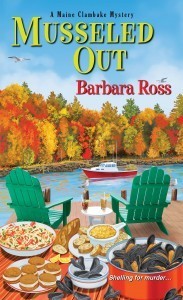 We’ve had one of our trademark beautiful falls in New England this year, but the last few days, a nor’easter has been lashing at us. That’s put me in mind of this delicious recipe that my husband Bill Carito developed for Musseled Out, the next book in the Maine Clambake Mystery series.
We’ve had one of our trademark beautiful falls in New England this year, but the last few days, a nor’easter has been lashing at us. That’s put me in mind of this delicious recipe that my husband Bill Carito developed for Musseled Out, the next book in the Maine Clambake Mystery series.
This slow-cooker stew is delightful, mixing so many great fall flavors. The base can cook all day with the fish and kale added an hour before serving.
Ingredients
2 Tablespoons olive oil
3 ounces pancetta, diced
½ pound kielbasa, cut into half-inch rounds
2 medium onions, sliced
1-2 red peppers, quartered and cut into thick slices
3-4 fat cloves garlic, chopped
2 Tablespoons curry powder
½ teaspoon cayenne
1 Tablespoon lemon juice
1 Tablespoon kosher salt
1 Tablespoon brown sugar
1½ Tablespoon fresh ginger, grated
2 cups dried chickpeas, soaked overnight
1 pound butternut squash, cut into large pieces
1 small to medium head cauliflower, cut into florets
3-4 cups diced tomatoes or 1 28 oz. can with juices
4 cups vegetable broth
1½ pound fish such as pollock or cod, cut into thick pieces
8-10 ounces chopped kale
1 13.5-ounce can coconut milk
Instructions
 Heat oil in pan on medium heat. Add pancetta and lightly brown, about four to five minutes. Add kielbasa rounds and lightly brown, about three minutes.
Heat oil in pan on medium heat. Add pancetta and lightly brown, about four to five minutes. Add kielbasa rounds and lightly brown, about three minutes.
Add onion, peppers, and garlic and soften, about three minutes. Stir in curry powder, cayenne, lemon juice, salt, brown sugar, and ginger. Deglaze pan with a 1/2 cup of broth, if necessary, and scrape everything into slow cooker.
Add soaked chickpeas, squash, cauliflower, tomatoes, and vegetable broth.
Cook on low for seven hours. Add fish and kale and cook another forty-five minutes. Add coconut milk, adjust seasonings and cook fifteen minutes to meld flavors. Serve with crusty bread.
Enjoy!
October 22, 2014
A Cliché In Time Is Worth Two In The Bush by Al Lamanda
I live in a really peaceful cove on a medium-sized lake in the country. This quiet setting is ideal for inspiration and writing. Most of the time. My closest neighbor is an eighty-five-year old man who looks and acts exactly like the Lucky Charms leprechaun on a sugar high. He is a retired history teacher and his opinion of fiction, especially mystery/crime fiction is right up there with his opinion of stepping in dog poo. So he sees fit to drop in on me whenever he feels like it and he feels like it almost every day. Since I don’t write non-fiction history books I can’t possibly be busy. Right?
Anyway, a few weeks ago on a Sunday afternoon, the leprechaun opens my front door, walks in and takes a seat on the sofa. He turns on the television and goes nuts with the remote until he finds a football game to watch. (cause I can’t possibly be busy. right?) I was in the middle of a paragraph and did my best to tune the leprechaun out. However, he is the type of leprechaun that isn’t content to just walk in uninvited, watch my TV and eat the candy in the candy dish on the end table, no…no…no. He is a very vocal and animated leprechaun who feels compelled to shout at the TV as if the announcers of the game not only can hear him, but should also follow his expert advice.
“Don’t cry over spilt milk,” I heard the leprechaun shout at the TV when there was an argument over a penalty. A few minutes later, he shouted, “That’s it, that the whole nine yards.” And still later, “At the end of the day you lose.”
By now I had given up all thoughts of writing and wandered over to my sofa just in time to hear the leprechaun say, “It’s in overtime. They had an ace up their sleeve.”
I reached for a Snicker’s mini-bar in the candy dish and the leprechaun said, “Help yourself.” I did and looked at the TV. “The quarterback put his eggs all in one basket, that’s why it’s in overtime,” the leprechaun said. A few minutes later the kicker kicked a field goal and the game ended. “The rest is history,” the leprechaun said.
That’s when I realized that my history teacher leprechaun neighbor spoke almost entirely in clichés whenever he made a point. (seems like it to me, anyway) I politely pointed this out to him and he said, “That’s a far cry from the truth.” Getting a bit aggravated here, I asked, “What does that mean, a far cry from the truth? Is somebody crying when they tell a lie? Is the truth far, far away, what?” The leprechaun, sensing my aggravation tried to calm me down by saying that we should, “Bury the hatchet,” and “Call it a day.”
We did and he left, but only after the candy dish had been emptied. I turned off the TV and returned to my desk, but the damage had been done. My head was now filled with clichés. Tired, stale, overused clichés. For a writer, a cliché is a death sentence. If I read a cliché in a book I am most likely not going to finish that book.
Clichés are everywhere these days it seems, even on the news. The one I hate the most is also the most overused one, the At The End Of The Day cliché that every talking head on the news uses over and over again to make their point.
So if you write for a living, avoid using clichés at all costs. Using clichés means poor and lazy writing and that you have nothing original to say. Don’t believe me. Pick up a book, any book and if you read the phrases Against All Odds, American As Apple Pie, As The Crow Flies, and Back Against The Wall within the first few pages, I can pretty much guarantee it’s a book you won’t finish. A book you’ll Avoid Like The Plague, so to speak.
With that in mind, I compiled a list of the clichés I hate the most. I’m sure you have your own list and many will overlap.
Don’t Cry Over Spilt Milk. (Usually I just wipe it up or wait for my cat to do it for me, but cry over it? Never.)
The Rest Is History. (Everything is history if you think about it.)
Avoid Like The Plague. (Umm, sure, no problem.)
Every Cloud Has A Silver Lining. (And you know this how?)
When It Rains, It Pours. (Except for those days when it lightly drizzles or is a steady, but moderate rain that ends with a beautiful rainbow.)
Cat Got Your Tongue? (I don’t even know what this means. Am I asking you to speak by somehow suggesting that my over zealous kitty has clamped down on you tongue and is preventing you from speaking?)
Dressed To Kill. (Exactly what does one wear when planning to kill someone? I missed that page in the Bean’s clothing catalog.)
Spitting Image. (Sounds messy and gross to me.
Don’t Judge A Book By It’s Cover. (Unless the cover is blank of all information about the story, title and author, how else am I to judge a book?)
Another Day, Another Dollar. (Okay, us author’s work pretty cheap, but a dollar a day? Come on)
All In A Day’s Work. (What if you’re on the night-shift?)
Beat A Dead Horse. (Who, I ask you who, would do this?)
Best Thing Since Sliced Bread. (Sliced bread is not that big of a deal, really. You get some bread, you slice it. It even comes already sliced and ready to go, if, at the end of the day you’re too tired to slice it yourself.)
Beggars Can’t Be Choosers. (Of course they can, especially if they choose to beg.)
Bored To Tears. (I usually just take a nap when I’m bored. Cry when I’m bored, never.)
Open A Can Of Worms. (What store sells worms in a can?)
Cross That Bridge When You Come To It. (I’d like to see you cross that bridge before you reach it.)
Dead As A Doornail. (Somebody write me if you have ever used nails that were living.)
Dressed To The Nines. (Somebody? Anybody? Write me if you’ve ever left the house wearing a nine.) There are a lot of theories on this one, but no one is really sure.
It Goes Without Saying. (Then shut up and don’t say it.)
Okay, that’s my list of the clichés I hate the most. I’m sure you have your own. The important thing is that (insert at the end of the day here) agents and publishers will judge your work by the number of clichés you use in your writing and most likely reject it as lazy writing.
Now if you’ll excuse me, I see a leprechaun coming up my driveway and I’m going to hide the candy dish and lock my doors. Just remember that, at the end of the day using too many clichés is the kiss of death for a writer.
Collecting … Stories … and Scottish Jewelry

The Cairngorm pin my grandmother left me.
I’m Lea Wait and, as many of you know, I’ve been involved with antiques all of my life. My great-grandfather sold antiques and fine Scottish and Irish silver, crystal and linens in his Boston shop over a hundred years ago. My grandmother was a dealer in antique dolls and toys; her business was very like that of Gussie’s in my Shadows Antique Print Mystery Series. And my mother and I were (and I still am, although I’m not as active as I used to be) antique print dealers.
I grew up in a family of both dealers and collectors. (And, yes, there’s a difference!) My father collected ivory carvings and scrimshaw. And then broken bank notes (paper money from American banks that went bankrupt.) My sister Nancy collected Thomas Nast cartoons and wood engravings and letters. My sister Doris collected miniature Mercedes-Benz cars, and vintage Fiestaware dishes. Me? When I was a teenager I collected political memorabilia and old postcards and out-of-print Edith Wharton books. When I was older I collected special Christmas tree ornaments and old Santa Clauses.
My daughter Ali collects niello jewelry from Thailand, where she was born. My daughters Caroline and Elizabeth collect Spode Christmas Tree china. One
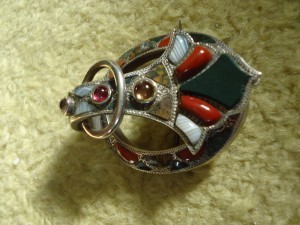
Cairngorm piece that may be worn as a pin, pendant – or scarf clip. I bought it in Edinburgh.
of my grandsons has growing collections of baseball cars and LEGOs.
But in recent years tastes (and space) have changed. I’ve sold my political and postcard collections. My sister donated her Nasts to a museum. There is a limit to how much china you can actually use and hundreds of Santas can become too many Santas.
Today I don’t really collect anything (the thousands of books in my home don’t count, really, because I use them as well as admire them. And that’s my story.)
But I do have some family pieces I value, and that I won’t part with.
One small collection I have is of Scottish jewelry. My grandmother, who came from Scotland, always called it “Cairngorm” jewelry, and left a piece of hers to each of my sisters and I. In Scotland today it is called “pebble jewelry,” and souvenir shops sell imitations of the real thing. In the Harry Potter movies, actress Maggie Smith wears one.
Real pieces are different colored agates and other Scottish stones set in sterling silver settings. They became popular, along with tartans, after Queen Victoria and Prince Albert bought their Scottish castle, Balmoral, in 1852. Victoria and Albert often dressed in tartans, and so did their children. Some of the first pieces of “pebble” jewelry were kilt pins.
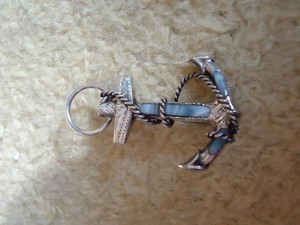
Cairngorm anchor pin.
Agates include amethyst, citrine, carnelian, jasper or bloodstone … they can be cloudy or clear or transparent. In this jewelry, small pieces of stone are cut and set to be level with their silver settings. I have one piece which is just one stone; others have perhaps two dozen stones.
I first loved them because my grandmother loved them. And then I loved them more when I found out more about them. And that’s the best reason for having a collection.
For example, one of my pieces has a special meaning … it’s in the shape of an anchor. Anchor pins were worn by Scots who fished off the East Coast of Scotland, especially those who worked out of Aberdeen. Like the heavy sweaters they wore, knit especially for them by wives and mothers and sweethearts, the pins were worn to bring good luck on the waters and, if fate was not with their owners, to help identify their body so they could be brought home.
I love that my book Seaward Born, although not set in Scotland, pictured a drawing of an anchor very like my pin at the beginning of each chapter. That pin has inspired other stories, too … one of my “not ready for publication” books is about one of these anchor pins, and those who wore it.
I often look at the pieces of Pebble Jewelry I have and wonder about those who wore them before I did. Because, like all antiques, each piece has a story.
And that’s what I’ve always thought collections were: symbols of the stories they told.
Oh yes, even FOOD can be scary
We’re entering the Halloween season, when pumpkins abound and houses and bushes are bedecked with spiders and ghosts and witches. But as crime writers, our minds often also turn to whimsy at the table. So here, for your seasonal delectation, are some ways you can make your dinners as scary as your decorations.
How about Spooky Spider Eggs?
Everyone loves chocolate cake, right? And frosting? So here’s how, with just a few small additions, you can make it look absolutely spooky. Yup. Red food coloring and a carving knife.
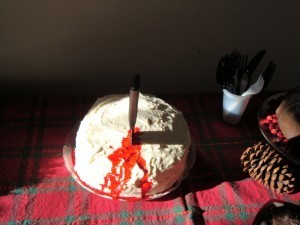
A red velvet cake with a twist?
Roasted brains, anyone?
Okay, so this is really whole roasted cauliflower, but it sure would look spooky on your Halloween table. Here’s the recipe: http://www.purewow.com/entry_detail/recipe/8821/Use_Your_Head.htm?referrer=rss_recipe
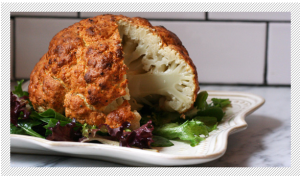
And for more creepy ideas, try these websites:
http://www.homeeverafter.com/best-creepy-halloween-food-ideas/
http://www.delish.com/entertaining-ideas/holidays/halloween/scary-halloween-recipes#slide-1
Stay tuned for our Halloween specials, when Maine librarians tell us about their scariest books.
Lea Wait's Blog
- Lea Wait's profile
- 509 followers




